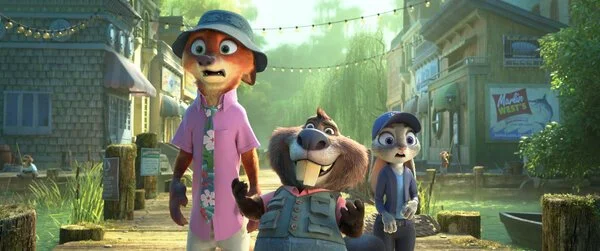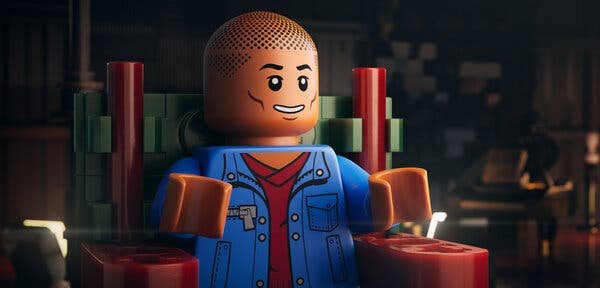ZOOTOPIA 2
Directing: B
Acting: B
Writing: B-
Cinematography: B
Editing: B-
Animation: B+
If you really want to see a movie as delightful as Zootopia (2016), nine years later, then . . . why not just watch Zootopia again? That’s what I did, and I had a blast. I nearly forgot how good it was, how clever, how consistently funny. I probably would have enjoyed Zootopia 2 more had I not watched both movies one day after the other.
Which is not to say I didn’t enjoy Zootopia 2; I did, generally. It’s the “generally” that I’m a little hung up on, because this new film is something that takes a clever concept and then does little more than rehash it. A ton of the gags in this film aren’t even original, but rather simply a trotting out of the hits we already saw in the first one. You might not be as prone to noticing this if you don’t watch the films back to back, but you might still notice that Zootopia 2 has a bit of old-school sequel-itis. I kept thinking about Die Hard 2, and how many characters it brought back from the first film for the sake of nothing but having us say, “Hey! That guy!”
As always, none of this is going to matter to kids. They’ll just eat this up, I’m sure. But what historically sets Disney apart from other animation is how well it works as entertainment for grownups as well as the kids. To be fair, Zootopia is still relatively entertaining for adults too, albeit in a bit more of a pandering way. Disney has just been far better at it in the past—including the past Zootopia movie, which had a sly message about unlearning prejudices and a consistently effective sense of humor at the same time. A lot of the gags here feel kind of like they would have been cut from the first film, and then just got reassembled here.
We even get a return of Shakira as the pop star Gazelle, right down to the “live concert” footage that plays with the first few minutes of the end credits. Beat for beat, Zootopia is simply the same experience as Zootopia, just without the novelty or certainly any of the originality. Granted, even the original Zootopia recalled the 1973 animated Disney film Robin Hood, a favorite of mine in childhood, but at least it put a new spin on the concept. There are no new spins to be found in this new film, which throws out a lot more movie reference gags for the grown-ups: a hedge maze with the iconic The Shining synthesizer score, a brief reappearance of Bellwether the sheep (Jenny Slate) behind a glass wall like The Silence of the Lambs (get it?). Unlike the first film, in which a reference to The Godather also served to move the story forward, these references exist only for their own sake.
They’re still fun, I guess. And although the relationship between Judy Hopps the bunny (Ginnifer Goodwin) and Nick Wilde the fox (Jason Bateman) strangely skirts the edges of romance but consistently lands firmly in the realm of “friendship,” an inevitable rift between them and their subsequent emotional reconciliation actually got my eyes a little damp. Maybe I’m just getting as soft as these animals.
Except, here’s the “twist” in Zootopia 2: instead of a society consisting only of mammals (side note, maybe my favorite gag was when they crash a “Burning Mammal” festival), we learn of an underground society of reptiles, pushed to the edges of Zootopia a century ago, the city being tricked into thinking of them all as untrustworthy. Never mind that this is nearly identical to the rift between two factions in the first film, predator versus prey. The cartoon logic of how these animals “evolved” made more sense in the first film, but the more into the weeds it gets in this second film, the less the logic holds. Not that cartoons were ever meant to be logical, I get it! There’s still something to be said for skilled weaving of a narrative, and Zootopia 2 is just a slightly degraded copy of an original. We do get a snake voiced by Ke Huy Quan, and a beaver voiced by Fortune Feimster. The aquatic mammal borough of Zootopia proves more fun and interesting than the reptile underground.
The animation is very well rendered, if often hard to focus on with all the quick-cutting action. The plot holds okay, as we learn about “weather walls” that control separate climates for different borough/habitats of the city, while I find myself wondering how any of them can visit any other, more inhospitable environments for any real amount of time and in so doing keep a whole city humming. But then, I think too much. It’s not that deep, right? Except Zootopia 2 clearly wants it to be, what with the continued, and slightly less sly, messaging about accepting each other for who we truly are. The allegorical component remains strong in this film, it just has a comparative lack of finesse. It’s just fun enough, but unexceptional, time at the movies.
I never thought I’d be this happy about the distraction of a beaver.
Overall: B










